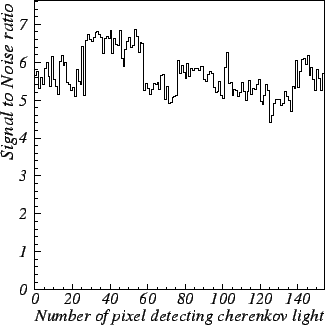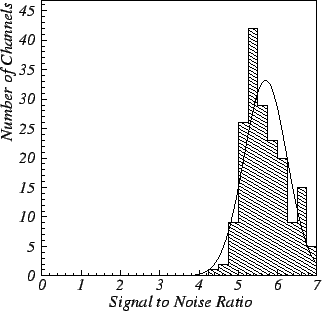


Next: Alignment of the silicon
Up: Performance of a Prototype
Previous: Experimental arrangement
Data selection criteria
On receipt of a trigger signal, the charge accumulated on each pixel
of each HPD is read out, digitised by an ADC and written
to disk. Events are then selected for data analysis by simply
requiring that there is at least one ``hit pixel''. The threshold for
a hit pixel is defined by requiring that the recorded ADC value
for that channel lies more than a certain number of pedestal
sigma4away from the pedestal mean. These thresholds are determined for each
channel separately, and are calculated using dedicated pedestal runs
which are interleaved between data-taking with beam.
The choice of threshold (or sigma cut) is primarily determined by the
signal-to-noise response of the HPDs. The signal-to-noise of
each pixel is determined by measuring the photon peak separation, from
spectra obtained from dedicated runs with a pulsed LED, and
comparing it with the width of the measured pedestal distribution.
The results for approximately
 of the total channels are
shown in Figure 5.
of the total channels are
shown in Figure 5.
Figure:
Signal-to-noise ratios for a subset of the
HPD detector channels.
 |
The projection of this distribution is shown in
Figure 6 and yields a mean of 5.7 and a spread of 0.6
for 181 pixels on 5 HPDs.
Figure:
Distribution of channel-by-channel
signal-to-noise ratios for a subset of the HPD detector channels.
 |
The stability of the noise pedestals, observed over several weeks at a
time, indicates that, for the majority of channels, any change in
pedestal width with time is less than 7% of a typical photoelectron
signal. In addition, 3% of the channels were dead due to the readout
electronics and 0.7% noisy due to high leakage currents in the
silicon.
The value used for the sigma cut on hit pixels is analysis dependent.
It represents a compromise between the efficiency of photon selection
and the purity of the sample obtained. Typically a 3 sigma cut
results in an efficiency of  85% for selecting signal photons,
with a small background due to electronic noise. Cuts at 4 or 5
sigma are significantly less efficient but are effectively free of
background. Variation of this selection is used to estimate
systematic uncertainties.
85% for selecting signal photons,
with a small background due to electronic noise. Cuts at 4 or 5
sigma are significantly less efficient but are effectively free of
background. Variation of this selection is used to estimate
systematic uncertainties.
The threshold Cherenkov detector is also used to estimate systematic
uncertainties by selecting varying beam compositions. This is
achieved by setting a threshold which determines the accepted kaon and
antiproton contamination. The silicon telescope planes have a
signal-to-noise ratio better than 20 : 1, and so a simple cut is made to
select these with negligible contamination from noise.



Next: Alignment of the silicon
Up: Performance of a Prototype
Previous: Experimental arrangement
latex2html conversion by www person on 2000-01-23
![]() of the total channels are
shown in Figure 5.
of the total channels are
shown in Figure 5.

![]() 85% for selecting signal photons,
with a small background due to electronic noise. Cuts at 4 or 5
sigma are significantly less efficient but are effectively free of
background. Variation of this selection is used to estimate
systematic uncertainties.
85% for selecting signal photons,
with a small background due to electronic noise. Cuts at 4 or 5
sigma are significantly less efficient but are effectively free of
background. Variation of this selection is used to estimate
systematic uncertainties.